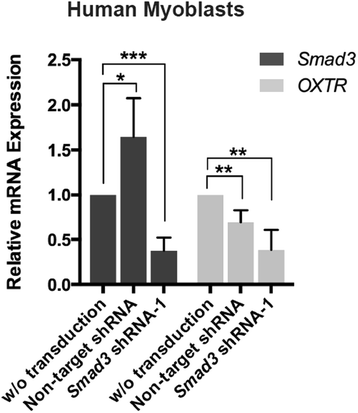Unexpected evolutionarily conserved rapid effects of viral infection on oxytocin receptor and TGF-β/pSmad3
- PMID: 28506310
- PMCID: PMC5433165
- DOI: 10.1186/s13395-017-0125-y
Unexpected evolutionarily conserved rapid effects of viral infection on oxytocin receptor and TGF-β/pSmad3
Abstract
Background: shRNA lentiviral vectors are extensively used for gene knockdowns in mammalian cells, and non-target shRNAs typically are considered the proper experimental control for general changes caused by RNAi. However, the effects of non-target lentivirus controls on the modulation of cell signaling pathways remain largely unknown. In this study, we evaluated the effect of control lentiviral transduction on oxytocin receptor (OXTR) expression through the ERK/MAPK pathway in mouse and human skeletal muscle cells, on myogenic activity, and in vivo on mouse muscle regeneration. Furthermore, we mined published data for the influence of viral infections on OXTR levels in human populations and found that unrelated viral pathologies have a common consequence: diminished levels of OXTR.
Methods: We examined the change in OXTR mRNA expression upon transduction with control and Smad3-targeting viral vectors through real time RT-PCR and Western blotting, and confirmed with immunofluorescence. Changes in Smad3 and OXTR expression were examined both in vitro with mouse and human myoblasts and in vivo in mouse satellite cells. The general effects of viral infections on OXTR downregulation in humans were also examined by analyzing published Gene Expression Omnibus (GEO) datasets. The change in myoblast myogenic activity caused by the viral transduction (the percent of Pax7 + Ki67+ cells) was examined by immunofluorescence.
Results: Results shown in this work establish that lentiviral control vectors significantly downregulate OXTR expression at mRNA and protein levels and diminish key downstream effectors of OXTR, ERK signaling, reducing the myogenic proliferation of infected cells. This effect is evolutionarily conserved between mouse and human myogenic cells, and it manifests in satellite cells after control lentiviral transduction of mice in vivo. Furthermore, an examination of published datasets uncovered similar OXTR downregulation in humans that are afflicted with different viral infections. Additionally, cells transduced with Smad3-targeting shRNA downregulate OXTR even more than cells transduced with control viruses.
Conclusions: Our work suggests that experimental cohorts transduced with control viruses may not behave the same as un-transduced cells and animals, specifically that control viral vectors significantly change the intensity of key cell-signaling pathways, such as OXTR/ERK. Our results further demonstrate that lentiviral transduction significantly decreases myogenic proliferation and suggest that viral infections in general may play a role in decreasing muscle health and regeneration, a decline in metabolic health, and a lower sense of well-being, as these rely on effective OXTR signaling. Additionally, our data suggest pathway crosstalk between TGF-β/pSmad3 and OXTR, implying that sustained attenuation of the TGF-β/pSmad3 pathway will reduce pro-regenerative OXTR/pERK signaling.
Keywords: ERK; Muscle Regeneration; Oxytocin Receptor; RNAi; Smad; TGF-β; Viral Vectors; Viral infections.
Figures





References
Publication types
MeSH terms
Substances
LinkOut - more resources
Full Text Sources
Other Literature Sources
Medical
Miscellaneous

